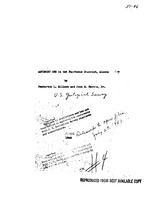Antimony-bearing ores in the Fairbanks district, Alaska, are found principally in two areas, the extremities of which are at points 10 miles west and 23 miles northeast of Fairbanks; and one of two minor areas lies along this same trend 30 miles farther to the northeast. These areas are probably only local manifestations of mineralization that affected a much broader area and formed antimony-bearing deposits in neighboring districts, the closest of which is 50 miles away. The ores were exposed largely as a result of lode gold mining, but at two periods in the past, high prices for antimony ore warranted an independent production and about 2500 tons of stibnite ore was shipped.
The sulfide deposits occupy the same fractures along which a gold-quartz mineralization of greater economic importance occurred; and both are probably genetically related to igneous rocks which intrude the schistose country rock. The sulfide is in part contemporaneous with some late-stage quartz in which it occurs as disseminated crystals; and in part the latest filling in the mineralized zones where it forms kidney-shaped masses of essentially solid sulfide. One extremely long mass must have contained nearly 100 tons of ore, but the average of the larger kidneys is closer to several tons. Much of the ore is stibnite, with quartz as a minor impurity, and assays show the tenor to vary from 40 to 65 percent antimony. Sulphantimonites are less abundant but likewise occur as disseminated crystals and as kidney-shaped bodies. Antimony oxides appear on the weathered surface and along fractures within the sulfide ore.
Deposits containing either stibnite or sulphantimonite are known at more than 50 localities, but only eighteen have produced ore and the bulk of this came from the mines. The geology of the deposit, and the nature, extent, and period of the workings are covered in the detailed descriptions of individual occurrences.
Several geologic and economic factors, which greatly affect prospecting and mining for stibnite ore in the area, are outlined. The principal available ore and reserves are considered to be ores earlier mined but never shipped, ore minable from near-surface deposits, and ores recoverable as a by-product of future gold mining. The outlook for stibnite production in the district is very uncertain. Apparently the greater portion of stibnite ore has already been recovered and present operations will strip the two principal areas of the district. This conclusion is based on the scanty discoveries since the last war and the fact that the areas are so pock-marked with prospects that there is little likelihood that any other large near-surface bodies remain to be discovered. Future prospecting would essentially be limited to attempts to seek the continuation of lodes previously having high yields of stibnite.


